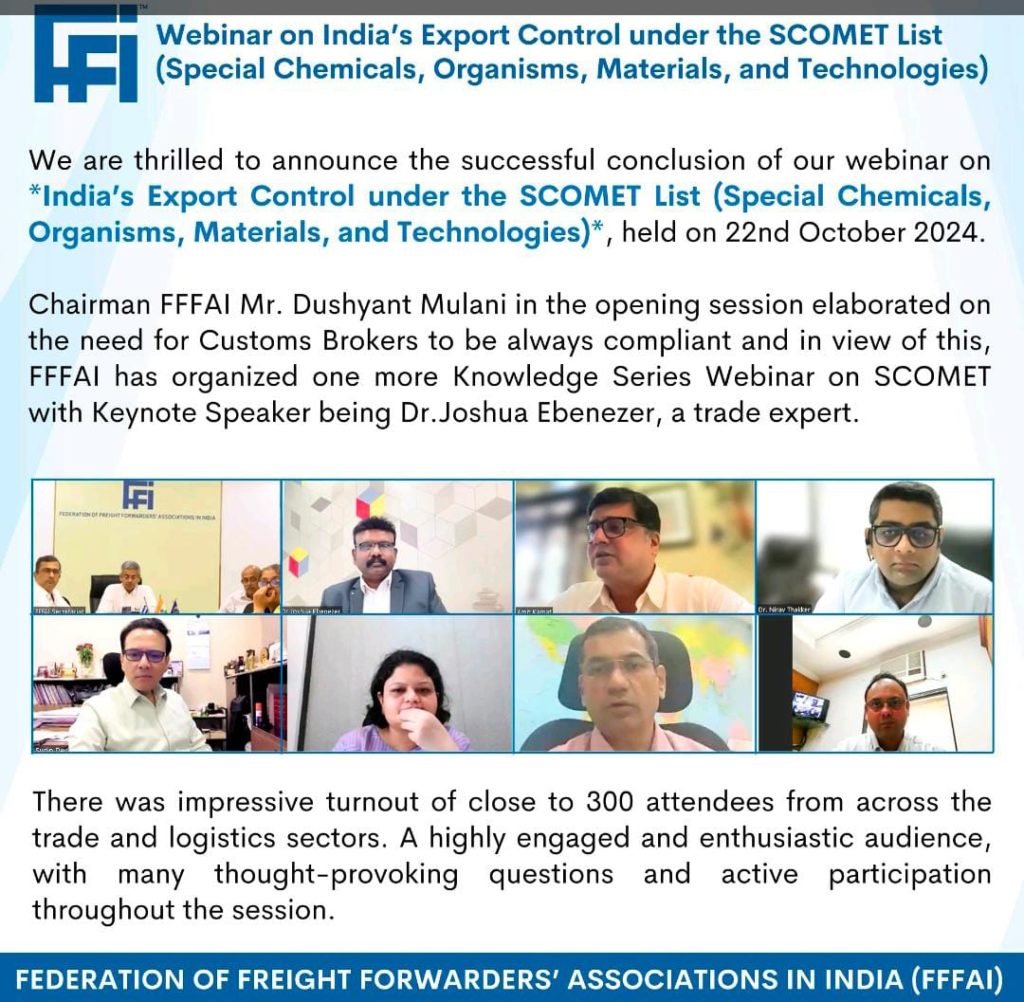Articles
FFFAI Webinar

Revolutionizing Customs
World Trade Expo 2024
Voice of MTB
The Carriage of Goods by Sea Bill
A New Era of Transparency and Efficiency with the 2024 GI Rules
Global Trade Commitments and National Law-The Intersection of SCOMET and India's Constitutional Framework
In the contemporary globalized world, export controls are pivotal in ensuring national security while fostering trade. India’s Special Chemicals, Organisms, Materials, Equipment, and Technologies (SCOMET) list forms the foundation of its export control regime, especially for dual-use items. The recent A.R. SALES PVT LTD.
Balancing Legal Clarity and Legislative Fairness: The Finance Act, 2024 and the Customs Tariff Act
In the contemporary globalized world, export controls are pivotal in ensuring national security while fostering trade. India’s Special Chemicals, Organisms, Materials, Equipment, and Technologies (SCOMET) list forms the foundation of its export control regime, especially for dual-use items. The recent A.R. SALES PVT LTD. VERSUS UNION OF INDIA & ORS. – 2024 (8) TMI 729 – DELHI HIGH COURT. provides an important lens into interpreting and applying these controls in the Indian context, specifically concerning the Catch-All provisions that India incorporated as part of its international commitments under the Wassenaar Arrangement.
A New Era of Transparency and Efficiency with the 2024 GI Rules
The significance of Geographical Indications (Gls) in international trade has grown exponentially in recent years. Gls not only protect the unique characteristics of region-specific goods but also play a pivotal role in preserving the heritage, reputation, and economic value of these products. From Darjeeling Tea to Kanjeevaram Silk, Gls are a beacon of quality and authenticity.
With the introduction of the Geographical Indications of Goods (Holding Inquiry and Appeal) Rules, 2024, the landscape of GI protection and enforcement in India has been drastically improved. These new rules, notified on August 16, 2024, by the Ministry of Commerce and Industry, are a game-changer for businesses, artisans, and traders who rely on the integrity of Gls to distinguish their products in a globalized market.
Balancing Legal Clarity and Legislative Fairness: The Finance Act, 2024 and the Customs Tariff Act
In a landmark move, the Indian government introduced the Carriage of Goods by Sea Bill, 2024, in the Lok Sabha on August 9, 2024. This bill is set to replace the Indian Carriage of Goods by Sea Act, of 1925, which has governed the transportation of goods by sea in India for nearly a century. The new bill aims to align India’s maritime laws with international conventions like the Hague-Visby Rules, modernizing the framework to meet the demands of today’s global trade environment.
Revolutionizing Customs: How ICETABs are Transforming Trade Facilitation in India
The world of international trade is evolving rapidly, and India is no exception. With the government’s commitment to enhancing trade facilitation, transparency, and efficiency, the Central Board of Indirect Taxes & Customs has introduced a significant initiative: the use of ICETABS to streamline the customs examination and clearance process.
As outlined in Circular No. 10/2024-Customs, issued by the Ministry of Finance on August 20, 2024, ICETABS-mobile tablets-represent a crucial step toward simplifying procedures, reducing paperwork, and adopting best global practices. This initiative will bring faster processing times, greater transparency, and improved communication across stakeholders in India’s bustling trade environment.
Export Strategies for Indian Businesses: Adapting to Global Trade Challenges
In March 2018, the USA held consultations with the Government of India under Articles 1 and 4 of the Understanding on Rules and Procedures Governing the Settlement of Disputes (DSU) and Articles 4 and 30 of the Agreement on Subsidies and Countervailing Measures (SCM) about certain export promotion schemes administered by Government of India.
Navigating the Complex Waters of Harmonized System Classification: A Tale of Auto Components and Legal Precedents
In the intricate world of international trade, the process of classifying goods under the HSN in India has unfolded like a strategic game between importers and customs authorities, especially notable in the automobile sector. The landscape of auto component classification, marked by its propensity for higher customs duties, has consistently been a focal point for the Revenue’s scrutiny. The plot thickened with the implementation of the GST on July 1, 2017, setting the GST rate for auto components at a steep 28%.
Unexpectedly, a past Supreme Court verdict from July 2003 concerning G.S Auto International [2003 (1) TMI 700 – SUPREME COURT, which ratified the classification of various vehicle fasteners under heading 8708 using the ‘sole and primary use’ criterion, resurfaced. Despite the court’s clear stance, which contradicted the Revenue’s opposing view-a stance that had remained dormant for more than a decade this decision suddenly found new relevance.
Even the king of fruits isn’t immune to the might of trade compliance. In a costly episode this May, 15 consignments of Indian mangoes were rejected and destroyed by U.S. Customs and Border Protection (CBP) over documentation issues related to mandatory irradiation. The total financial loss: $500,000.
While the treatment itself had been carried out at a USDA-approved facility in Navi Mumbai, discrepancies in the USDA’s PPQ203 certification led to the consignments being denied entry at major U.S. airports, including Los Angeles, San Francisco, and Atlanta. Exporters were left stunned, as they had followed all protocol under USDA and Indian customs oversight.
This isn’t just a clerical error; it’s a reminder of the fine line between compliance and diplomatic leverage in international trade. The India & U.S. agricultural trade relationship has often been punctuated by similar episodes.
A New Era of Transparency and Efficiency with the 2024 GI Rules
The significance of Geographical Indications (GIs) in International trade has grown exponentially in recent years. GIs not only protect the unique characteristics of region-specific goods but also play a pivotal role in preserving the heritage, reputation, and economic value of these products. From Darjeeling Tea to Kanjeevaram Silk, GIs are a beacon of quality and authenticity.
With the introduction of the Geographical Indications of Goods (Holding Inquiry and Appeal) Rules, 2024, the landscape of GI protection and enforcement in India has been drastically improved. These new rules, notified on August 16, 2024, by the Ministry of Commerce and Industry, are a game-changer for businesses, artisans, and traders who rely on the integrity of GIs to distinguish their products in a globalized market.
